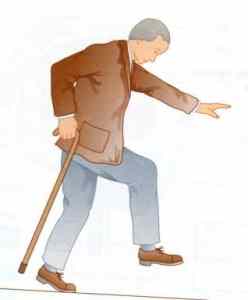

MedFriendly®


Sensory Ataxia
Sensory ataxia is an impairment of one's sense of
position that causes ataxia (uncoordinated walking) due
to a loss of sensory input into the control of movement.
WHAT CAUSES SENSORY ATAXIA?
Sensory ataxia is caused by damage located
somewhere along the central (in the brain and spine) or
peripheral (outside the brain and spine) sensory nerve
pathways. An example of the latter is peripheral
neuropathy affecting large sensory fibers. Peripheral
neuropathy is a general term for any disorder of nerves
outside the brain or spinal cord. This can make it
difficult to coordinate movements and maintain balance.
Unstable walking due to sensory ataxia.
FEATURED BOOK: Adams and Victor's Principles of Neurology
Another cause of sensory ataxia is damage to the dorsal (posterior) columns of the spinal
cord, which plays an important role in the sense of touch and position sense. There are
many factors that can cause damage leading to sensory ataxia such as infections,
poisoning, inherited diseases, a disorder of the body’s blood supply system,disorders
(e.g., multiple sclerosis) in which the immune system (defense system) attacks itself, or a
disorder of metabolism. Metabolism is a term for the chemical actions in cells that release
energy from nutrients or that use energy to create other substances. Multiple sclerosis is
a disease in which a loss of a substance around nerve fibers in the brain and/or spine
causes motor difficulties. Sensory ataxia is not caused by damage to the cerebellum, a
condition known as cerebellar ataxia (see below).
"Where Medical Information is Easy to Understand"™
WHAT ARE SIGNS OF SENSORY ATAXIA AND HOW DOES IT
DIFFER FROM CEREBELLAR ATAXIA?
Cerebellar ataxia is a loss of muscle coordination caused by
damage and/or degeneration of the cerebellum or connections to it.
The cerebellum is an area in the back, bottom part of the brain that
plays an important role in movement and coordination. Unlike
cerebellar ataxia, a person with sensory ataxia has near-normal
coordination when walking with the eyes open because the person
can use visual input to guide movements. However, when the eyes
are closed and the person must only rely on position sense and
touch, coordination will be much worse in sensory ataxia.
This is why people with sensory ataxia are prone to losing their balance and not knowing where their limbs
are in the dark, when closing their eyes (e.g., in the shower, washing one’s face), or pulling clothes over
the head. The latter can make it difficult to dress or undress the upper body. It is also why they
demonstrate a positive Romberg sign upon physical examination, which is imbalance when standing with
the eyes closed (usually with the arms held out). The arms tend to shake and wander during a positive
Romberg test. Another sign of sensory ataxia is pseduoathetosis which is abnormal writhing movements
(usually in the fingers) due to poor position sense.
Unlike cerebellar ataxia, sensory ataxia does not present with nystagmus or impairment of smooth eye
movements to pursue a target. Nystagmus is rhythmic involuntary jerking or swinging movements of the
eyes. Unlike cerebellar ataxia, sensory ataxia does not present with scanning dysarthria or pendular
tendon reflexes. Scanning dysarthria is a speech problem caused by cerebellum damage in which words
are broken into separate syllables, an observable pause, and spoken with variable force. Pendular deep
tendon reflexes are reflex responses in which the affected body part swings back and forth like a
pendulum due to cerebellum damage. Although the fingers may move out of position in sensory ataxia,
they are not likely to move in a fast and uncontrolled manner as can happen in cerebellar ataxia.
Sensory ataxia is characterized by striking the ground forcibly with the bottom of the foot as well as a stiff
fling of the leg. Patients with sensory ataxia appear slightly slow and uncoordinated. Slight tremor of the
extremities can also occur. The arms and hands may begin to drop due to weakness. When the arm is
pressed down, there may be a slight reduction of movement. Patients with sensory ataxia can present
with internuclear ophthalmoplegia (INO): an eye disorder in which the affected eye does not adduct
properly (i.e., will not move past the center) when looking to the opposite side. For example, when looking
to the right the left eye will not move past the center and when looking to the left the right eye will not
move past the center.
WHAT IS THE PROGNOSIS FOR SENSORY ATAXIA?
Sensory ataxia normally worsens slowly over time, especially if the condition causing the problem is not
treated. Treating the underlying medical cause can help improve sensory ataxia.
HOW IS SENSORY ATAXIA TREATED?
As noted above, treating the underlying medical cause can help improve sensory ataxia. Treatment can
include physical therapy, occupational therapy, medications, or nerve stimulation. Occupational therapy is
a health profession designed to develop, recover, or maintain activities of daily living and work skills in
patients. This can be helpful for patients with sensory ataxia because sensory ataxia can limit a person’s
ability to complete everyday tasks.
Recommendations for lifestyle adjustments can also be helpful such as using a flashlight or nightlight in the
dark or turning the light on in the dark when walking. Visual cues can also be helpful when trying to
navigate the environment.
WHAT IS THE ORIGIN OF THE TERM, SENSORY ATAXIA?
Sensory ataxia comes from the Latin word "sentire" meaning "to feel," the Greek word "a" meaning
"without," and the Greek word "taxis" meaning "order." The two words mean "to feel without order." The
word “order” refers to the order of movements.















